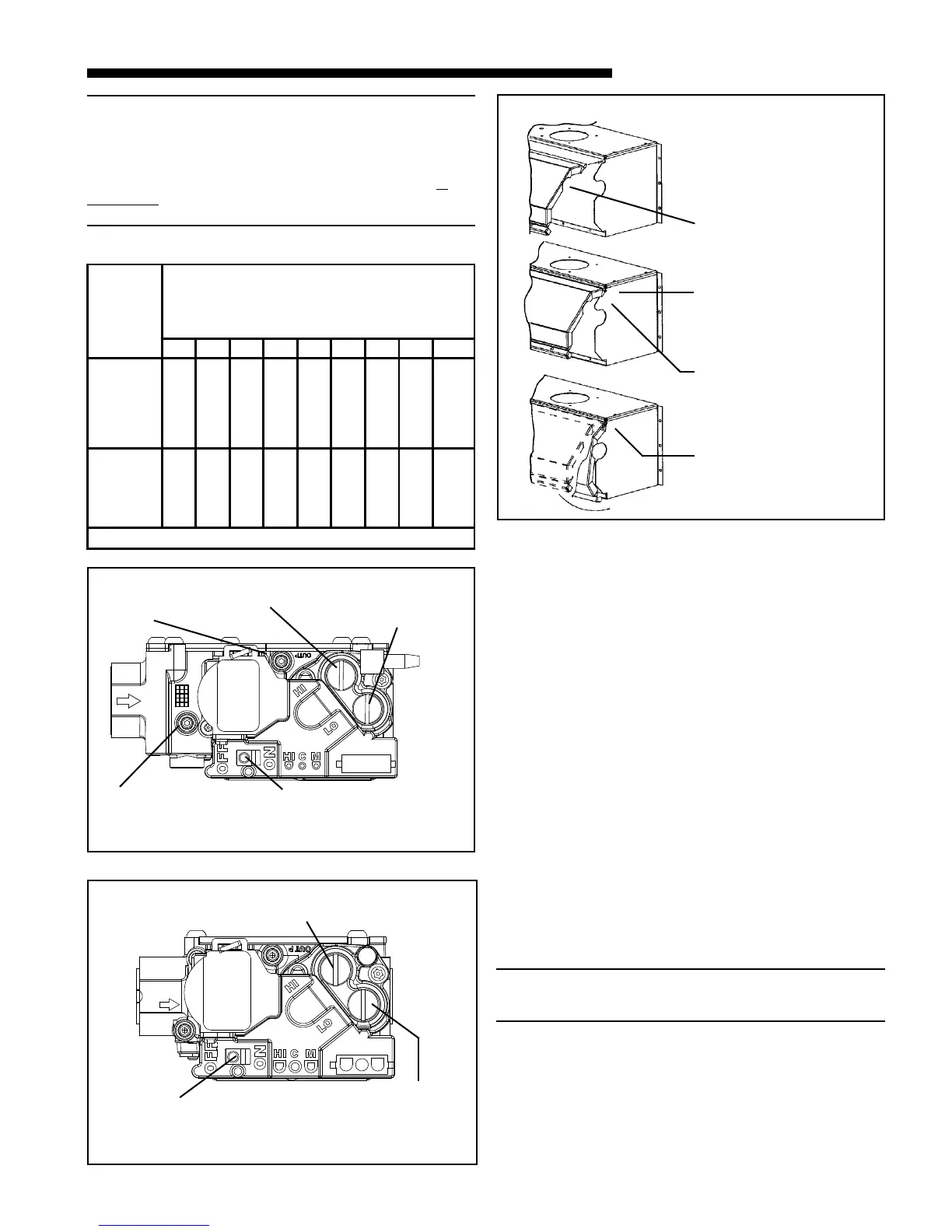18-CD19D8-18 33
Installer’s Guide
Orifice
Twist Drill
Size If
Installed
At Sea
Level
ALTITUDE ABOVE SEA LEVEL
and Orifice Required At Other Elevations
2000 3000 4000 5000 6000 7000 8000 9000 10000
42
43
44
45
46
47
42
44
45
46
47
48
43
44
45
47
47
48
43
44
45
47
47
49
43
45
46
47
48
49
44
45
47
48
48
49
44
46
47
48
49
50
45
47
48
49
49
50
46
47
48
49
50
51
47
48
50
50
51
52
54
55
56
57
58
54
55
56
58
59
55
55
56
59
60
55
55
57
59
60
55
56
57
60
61
55
56
57
60
62
55
56
58
61
62
56
56
59
62
63
56
56
59
63
63
56
57
60
63
64
From National Fuel Gas Code - Table F-4
ROTATE THE FRONT
COVER INWARD MAKING
SURE THAT ALL SIDE
FLANGES ARE OUTSIDE
OF THE BOX.
INSERT THE TOP FLANGE
OF THE FRONT COVER
UNDER THE LIP INSIDE
THE BOX
ALL SIDE FLANGES MUST
BE OUTSIDE OF THE BOX
ROTATE THE FRONT
COVER AS SHOWN
T
HIGH ALTITUDE DERATE
Input ratings (BTUH) of these furnaces are based on sea
level operation and should not be changed at elevations up to
2,000 ft.
If the installation is 2,000 ft. or above, the furnace input rate
(BTUH) shall be reduced 4% for each 1,000 ft. above sea level.
The furnace input rate shall be checked by clocking the gas
flow rate (CFH) and multiplying by the heating value
obtained from the local utility supplier for the gas being
delivered at the installed altitude. Input rate changes can be
made by adjusting the manifold pressure (min 3.0 - max
3.7 in. W.C. - Natural Gas) or changing orifices (orifice change
may not always be required).
If the desired input rate cannot be achieved with a change in
manifold pressure, then the orifices must be changed. LP
installations will require an orifice change.
IMPORTANT:
Reinstall the propane orifices to the same depth as the orifices
supplied with the equipment.
Installation of this furnace at altitudes above 2,000 ft.
(610m) shall be in accordance with the local codes, or in the
absence of local codes, the National Fuel Gas Code, ANSI
Z223.1/ NFPA 54 or National Standard of Canada, Natural
Gas and Propane Installation Code, CSA 149.1. Installation of
this furnace at altitudes above 2,000 ft. (610m) shall be made
in accordance with the listed high Altitude Conversion Kit
available with this furnace.
TABLE 18
See Table 18 for help in selecting orifices if orifice change is
required. Furnace input rate and temperature rise should be
checked again after changing orifices to confirm the proper rate
for the altitude.
The vent length table on page 16 shows the required vent
lengths for installations at various altitudes. An optional
high altitude kit is available for installations above 5000 feet
Installations above 12,000 feet are not allowed).
NOTE:
The manifold pressure must be referenced to the burner
box. The burner box pressure tap equalizes the gas valve
pressure regulator. Manifold pressure is checked by
installing a tee (field supplied) in the tubing, between the tee
coming from the burner box tube and the gas valve,
in
addition to
the regular gas valve pressure tap on the
outlet side of the gas valve. See Figure 52.
2nd Stage (HI) Manifold
Pressure Adjustment
Gas Valve On / Off
Toggle Switch
1st Stage (LO)
Manifold Pressure
Adjustment
Figure 53. White-Rodgers 36J
2nd Stage (HI) Manifold
Pressure Adjustment
Gas Valve On / Off
Toggle Switch
1st Stage (LO)
Manifold Pressure
Adjustment
Figure 54. White-Rodgers 36G
Outlet
Pressure
Boss
Inlet Pressure
Boss
